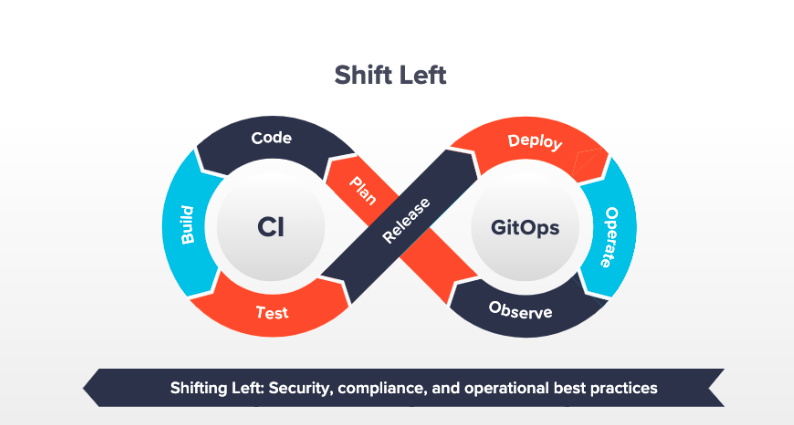Shift left security refers to performing security-related tasks earlier in the software development lifecycle to improve quality code while decreasing the time needed to identify vulnerabilities and risks. By doing this, shift-left security can help improve both code quality and time spent remediating vulnerabilities and risks.
Historically, cybersecurity and development teams worked in isolation from one another, leading to considerable friction and often leading to delays.
Shift left security refers to shifting important tasks, such as security testing, earlier in software development. Historically, such steps had often been left until late in development or even skipped altogether - this approach helps close any security gaps and boost application security.Shift-left approaches can also help eliminate clashes between developers and information security teams, which have traditionally been at odds as they strived to complete their respective portions of a project quickly and get applications into end-user hands quickly. A shift-left approach makes collaboration much smoother by encouraging teams to work together more closely toward producing applications on time for release with added security features.
Communication is of utmost importance when implementing shift left security, as everyone must understand each other's roles and responsibilities for it to work successfully. Developers need to know when to deploy fixes, while security teams must clearly communicate what they expect to find in any deployment.
Furthermore, having the appropriate tools in place is vitally important. A static analyzer is one tool that can assist with early vulnerability identification and coding error detection - saving both time and money by decreasing bugs that reach advanced stages in the software development lifecycle.
Best Practices for Getting Started
Beginning shift left security will require significant adjustments to how your software development process runs, which may take time and patience - as well as having access to all necessary tools - to be implemented successfully.
One of the most impactful changes you can implement is training developers on secure coding methods. By teaching developers these practices, early vulnerability identification and correction will save time in production by eliminating flaws earlier.

Automatic security testing should also be part of the continuous integration pipeline to simplify identifying security issues while decreasing human errors and test coverage gaps - helping prevent production workload vulnerabilities from being exploited further and mitigating their effect on business operations.
Early security implementation will also benefit your team by lowering overhead costs. Conducting vulnerability and penetration testing after the application has been released to customers can take up valuable resources and slow deployment times, so getting more done early will result in savings for both sides.
Finally, it is necessary to invest in DevSecOps practices that foster collaboration between developers and operations teams to detect vulnerabilities and rapidly address security threats. Doing this requires training on new processes and tools; however, this effort will pay dividends over time.
The importance of shift left security
Security risks that modern enterprises face are increasing quickly due to various factors, including software release cycles and cloud work being done increasingly often - neither of which allows vulnerabilities to be identified before it's too late.
Shift-left security can help organizations overcome these challenges by making it simpler to detect and resolve security issues during development, reducing costs by keeping vulnerabilities out of production environments, and ultimately helping organizations deliver more secure applications.
Developers and InfoSec teams must establish trust and collaborate to maximize the advantages of the shift left. To do so, this means shifting the culture in software development to incorporate security into DevOps processes.
Shift left security tools
Ideally, developers should integrate security testing throughout the development process, making it easier to detect vulnerabilities and defects early in the cycle, saving time and money. Furthermore, this approach ensures best security practices are built into every stage of development, known as shift left as part of DevSecOps principles.
Shifting left security requires collaboration between development teams and security engineers, although this can be challenging when these two groups have different perspectives and habits. Shifting security left requires building trust between teams and creating a common language of communication; additionally, tools supporting this philosophy must also be utilized so coding errors are detected early and corrected before becoming costly issues.
As part of the shift left initiative, companies should include security testing at an early stage of development to prevent bugs from making it into production and speed up development processes while testing for more vulnerabilities and threats.
On the market today are various shift left security tools, including static application security testing (SAST) and dynamic web application penetration testing (DWAP). SAST scans source code for vulnerabilities while DWAP performs vulnerability assessments on websites to detect known flaws - both tools aim to find flaws at the application layer - where attacks typically target.
Implementing shift left the security
Implementing shift-left security requires changing how software teams work. Integrating security testing early in the development process enables organizations to reduce time to market while ensuring secure applications are deployed faster. Organizations can speed up development cycles by automating testing processes and eliminating human errors from test coverage measures. At the same time, security teams focus on finding critical flaws or vulnerabilities before attackers exploit them.
Traditional application testing was often implemented during the final stages of development, leading to delays and bottlenecks that delayed software deployment and release. Shift-left security allows developers to detect and address potential vulnerabilities earlier in the SDLC cycle, speeding up development processes while improving application quality and speeding up time to market. Furthermore, this approach aligns more closely with DevOps methodologies emphasizing developer velocity and collaboration.
Shifting left security also allows developers to work more closely with security teams and share responsibility for testing and quality assurance (QA). Sharing responsibility for making code secure helps strengthen team communication while building trust between departments; organizations can deploy software more frequently by avoiding common bugs and security vulnerabilities.
